FLIR thermal imaging cameras provide solid proof for Italian court case
All over the world building issues lead to court cases. The biggest challenge in finding out the truth is to obtain solid facts. In many cases related to building issues, thermal imaging cameras from FLIR systems can provide exactly the kind of information needed to draw the right conclusions.
One example is an Italian court case about moisture ingress and mold formation in a new apartment complex. The inhabitants claimed that the building construction was flawed, while the building contractor claimed that the inhabitants were to blame, because they did not heat and ventilate the apartments properly. Inspections with FLIR thermal imaging cameras brought the matter to a close.
This case was brought before the court in Vicenza. Due to a lack of reliable information the technical consultant of the Vicenza court hired the services of the thermal imaging experts of Multites Srl. Founded in 2008, this thermal imaging consultancy agency is specialized in thermographic analysis and research of water infiltration.

Eviana Faccin, thermography consultant at Multites Srl.
Thermal bridges
“We inspected the disputed apartments from both from the outside and the inside and we found some significant heat leakage and thermal bridges”, explains Eviana Faccin, thermography consultant at Multites. "A thermal bridge is an area with less insulation. Heat follows the path of the least resistance. Often heat will short circuit through an element that has much higher conductivity than the surrounding material. This is called a thermal bridge. We found several of these thermal bridges in our inspections."
Further inspection showed that there was a direct link between mold formation and the thermal bridges. “The occurrence of the mold coincided perfectly with the thermal bridges. Every spot of mold was located on a piece of wall that showed up as a thermal bridge in the thermal images.”

This thermal image clearly shows heat leaking from the building.
Circumstances not ideal
The temperature differences between colder and warmer patches of wall ranged from 2° C to 5 ° C. “But it should be noted that the difference between inside and outside temperatures was lower than we recommend. Usually the best practice is to only inspect buildings when there’s at least a temperature difference between the inside temperature and the outside temperature of 10° C. In fall, however, these temperature differences would be difficult to attain, for the temperature inside the apartments would have had to be higher than 20° C, and letting the court wait several months until the seasons had changed was not an option in this case.”
“But although the temperature difference was not quite ideal at that moment the thermal imaging inspection clearly showed that the moisture damage and mold formation were caused by construction flaws”, continues Faccin. “Even if you consider the possibility that the tenants of the apartments made the situation worse by creating moist conditions on purpose, the existence of these thermal bridges clearly indicated that the damage in the apartments considered should be charged to the manufacturer.”

The temperature difference between the cold area in the corner and the rest of the wall is over 5° C.
‘Wide angle lens: very handy’
For this assignment Faccin used a FLIR B335 thermal imaging camera with a 45° lens. “I used this camera because it produces really good quality thermal images, but the fact that it has exchangeable lenses was very important as well. When you’re inspecting buildings you often don’t have the room to move away far enough to capture the part of the building you want to inspect in one thermal image. In that case the 45° wide angle lens comes in really handy.”
FLIR B335 thermal imaging camera
The FLIR B335 thermal imaging camera is designed especially for the building industry. FLIR has translated user feedback on comfort and clarity into a series of thermal imaging cameras that have comprehensive and innovative features, specially designed for building environments.
To produce reports, Faccin uses FLIR Reporter software. “This software program is very easy to use and it allows you to quickly and efficiently draw up a building inspection report. And because the software is fully compatible with Microsoft Office we can easily and swiftly compile reports with the most commonly used text editor: Word. Everybody can immediately start using the software, since most people know Word already.”

These images clearly show that the cold spots caused by thermal bridges exactly coincide with mold development.
The importance of training
“Thermal imaging technology is a great addition to the tools we have available for building diagnostics and in court cases such as this one they can provide crucial data”, continues Faccin. “But it is very important that you know what you’re doing. If you don’t know how to use the camera you cannot expect to achieve the result you want.”
To that end FLIR provides training in co-operation with the Infrared Training Center (ITC), the world's leading educational and training resource for thermal imaging professionals. The ITC offers high-quality interactive thermography training from the most qualified international thermography instructors. They give training courses in nearly 50 countries and in over 20 languages. Their internationally recognized certification program indicates the level of training as a Level 1, Level 2 or Level 3 thermographer.
According to Faccin training is very important. “Here at Multites we only employ thermographers that have at least thermography level 2. We feel that this is necessary to use the exciting thermal imaging technology to its full potential.”


